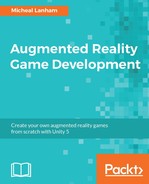In this chapter, we started out slowly by first understanding how to store the player's caught monsters. After that, we looked at a couple of database options before deciding on a cross-platform object relational mapping tool for SQLite, called SQLite4Unity3d. We wrapped the database into our new Inventory service and then wrote CRUD operations for our monster inventory items. From that, we determined we needed a better way to randomly generate monsters, so we developed a monster factory. That allowed us to loop back and complete the Catch scene by incorporating the monster factory for generating monsters and inventory service for storing caught monsters. With monsters being stored in the database, we then developed a new inventory scene to view caught monsters. Finally, we tied everything together with UI menu buttons and joined all the scenes together as a full game. Of course, the chapter ended by resolving some platform deployment issues.
For the next chapter, we will get back to exploring the AR world around the player and the map. We will extend the objects and places the player can interact with on the map through the use of some clever services. That will also require us to go to the next level in our GIS/GPS knowledge to explore spatial queries and other advanced concepts.
